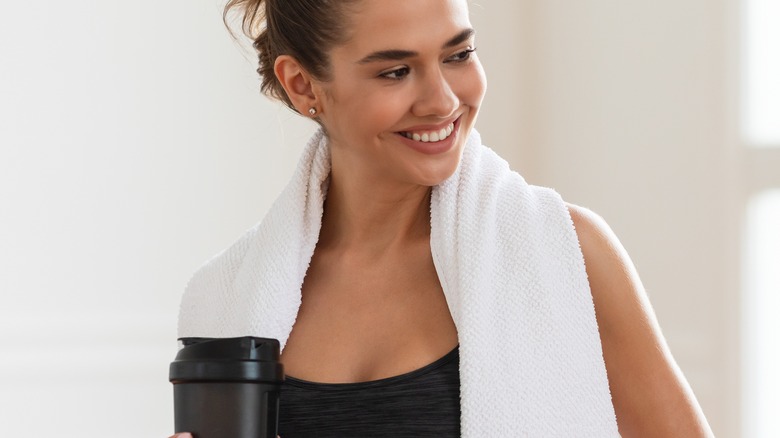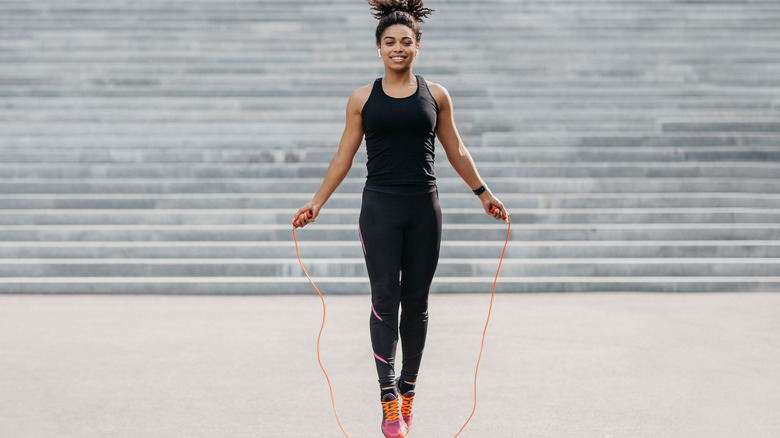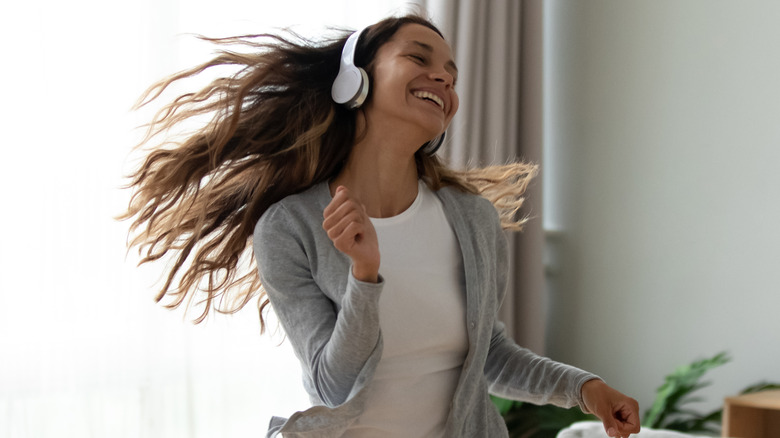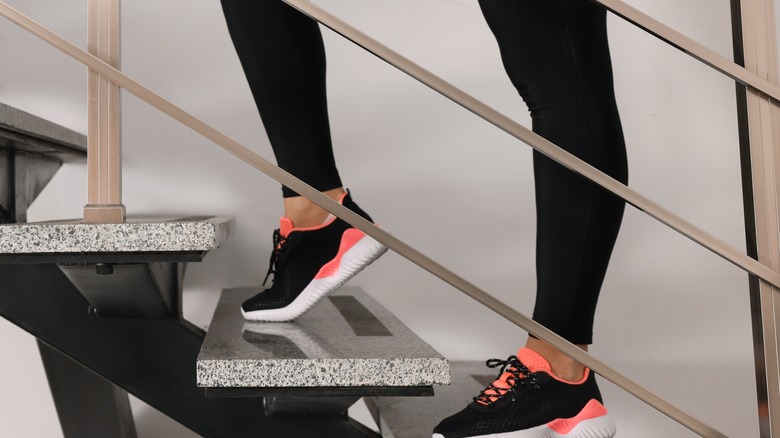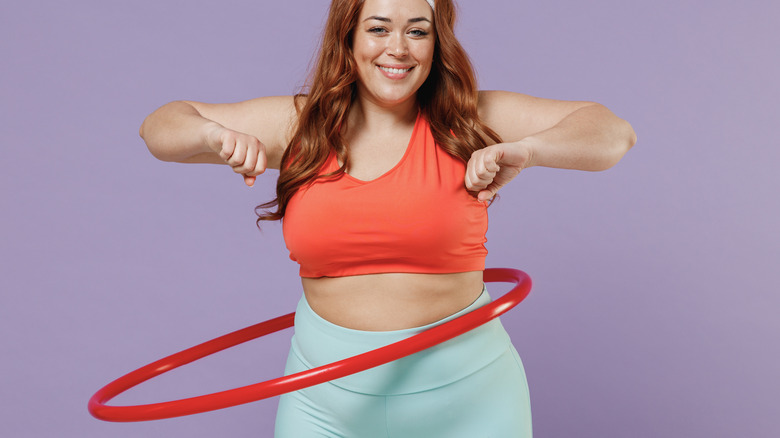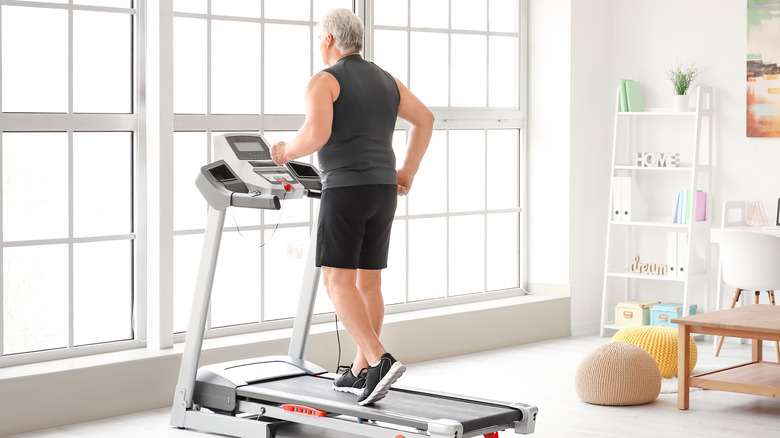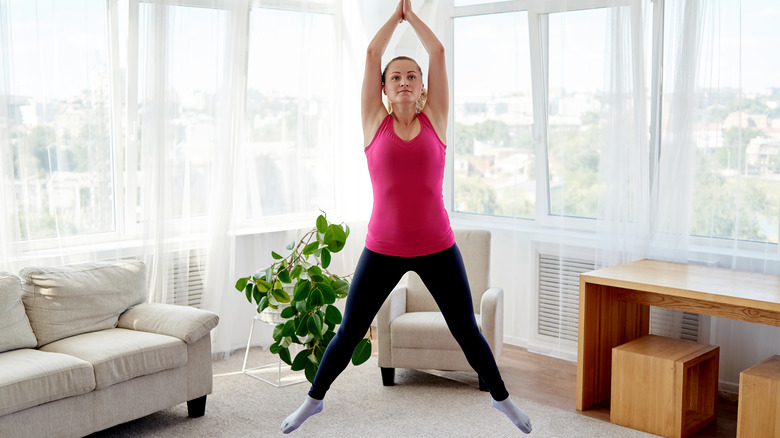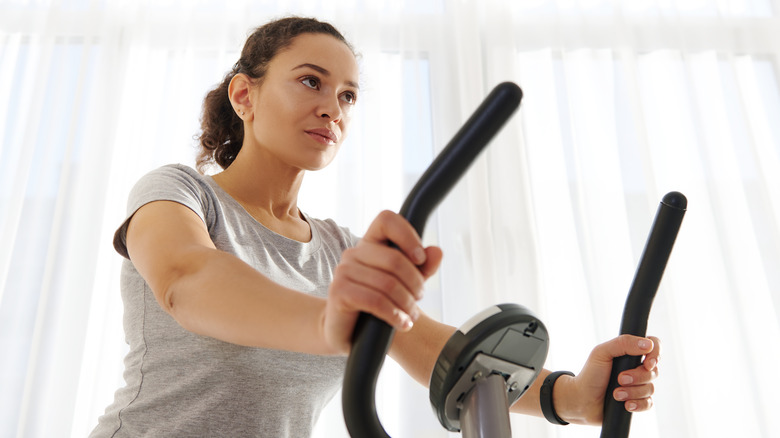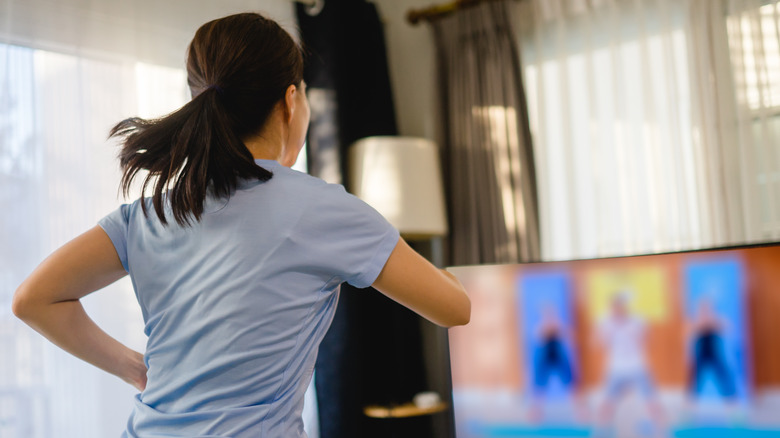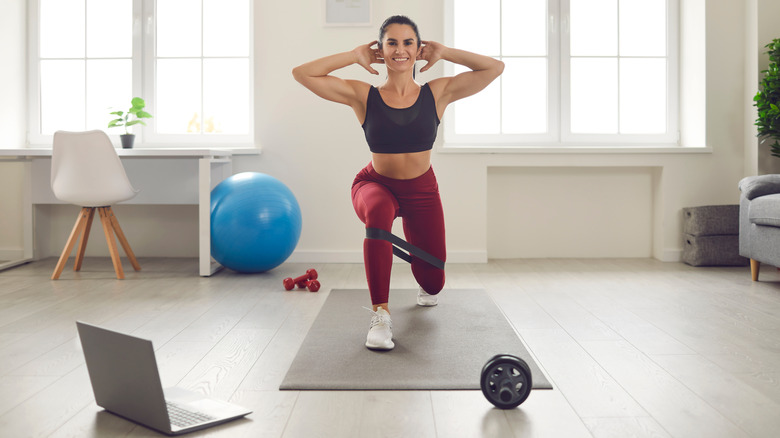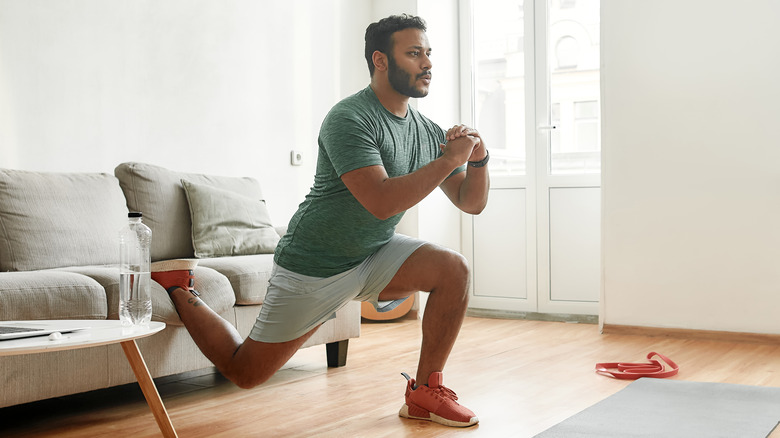Simple Cardio Workouts You Can Do At Home
When gyms shut their doors during the pandemic, people were forced to figure out new ways of getting their workouts in. Although it was tough to get used to at first, working out at home seems normal to many Americans now, who have found that they no longer need a gym membership just to stay in shape.
According to a 2021 survey, respondents said that working out at home has made exercise more convenient, giving them the flexibility to work out at whatever time's convenient for them and offering more choices of activities to do (via SWNS Digital). Respondents also mentioned that they felt they had more confidence to try new activities at home rather than in the gym. A whopping 72% said they thought the pandemic would make gyms "a thing of the past."
Still, it's not always easy to know what exercises to do. Cardio can be especially challenging, because it typically requires equipment or a lot of space that most people don't have. Home treadmills and stationary bikes are increasingly popular, and they're a great investment in your health (via Fortune Business Insights). But you have many other options that don't cost as much or require as much space. Here are a few simple cardio workouts you can do in the comfort of your own home.
Jumping rope
This childhood favorite playground activity is an incredible workout that takes little space, skill, or money, burns serious calories, and can kick cardio fitness into high gear. According to Nike, some of the benefits of jumping rope include burning calories, building cardiovascular fitness, and strengthening the arm and leg muscles. Jumping rope can also be considered a form of plyometric exercise, or jump training, which has unique benefits. In a 2020 study published by the International Journal of Sports Physiology and Performance, amateur runners who warmed up with jumping rope prior to endurance running training improved their speed, jumping ability, reactive strength and arch stiffness, which boosted their performance in a 3-kilometer time trial.
Important tips for getting started: You don't need any type of fancy rope, but you do need to make sure it's the right length for you (via Nike). To measure, stand on the center of your rope with both feet and a handle in each hand. Keep your arms straight and lift your hands to chest height. The ends of the rope (where it joins with the handle) should align with your armpits.
You also need a solid surface to jump on — preferably one that has a little give, like wood or rubber, which will be easier on your joints. As far as technique, you can jump single-leg or double-leg, but stay on the balls of your feet and land on bent knees to reduce the impact on your joints.
Dancing
You can get an excellent cardiovascular workout at home while dancing. According to a 2016 research review in the American Journal of Preventative Medicine, study participants who engaged in moderate-intensity dancing had a reduced risk of death from heart disease than the general public. Their mortality risk was even lower than participants who engaged in moderate-intensity walking for exercise.
Whether you enjoy waltzing, ballet, or hip hop, dancing at a moderate intensity is key to reaping the benefits. Per the Centers for Disease Control and Prevention (CDC), moderate-intensity activity is challenging enough to boost your heart rate and make you sweat. During moderate-intensity dancing, you could still have a conversation, but it would be difficult to sing. You can compare your dance workout to these common moderate-activity exercises: fast walking, water aerobics, playing doubles tennis, riding a bike on flat or slightly hilly terrain, or pushing a lawn mower.
You should also make sure you're dancing for at least 10 minutes at a time for it to count as cardio (via smokefree.gov). You could put on your favorite album and dance around your living room until it's over, or you could take a class. Online dance courses are becoming more and more popular, and you can find classes in every style under the sun. Plus, instead of just getting in a workout, you're also building a skill. According to a 2017 research review in Frontiers in Aging Neuroscience, learning to dance can improve your cognitive health.
Power yoga
Many people think of stretching and relaxation when they think of doing yoga. However, there are many different types of yoga, and some of them can be physically demanding. Power yoga involves moving quickly from pose to pose and doing challenging poses such as arm balances and inversions. It's intense enough to raise your heart rate and keep it elevated, just like common cardio workouts such as aerobics and running.
A 2018 study in Complementary Therapies in Clinical Practice measured heart rate, skin temperature, and fluid loss (sweat) during a 45-minute power yoga class and determined that power yoga can be considered a moderate- to vigorous-intensity form of exercise. Additionally, according to a 2017 study in the Journal of Health Psychology, you can still get the stress-reduction benefits from power yoga for which traditional, slower-paced yoga is lauded.
As a beginner, it's better to start out in a class with a live teacher who can make sure you're practicing proper alignment, but it's not necessary. You can find beginner power yoga classes online and just take it slow for the first couple weeks. Like any new activity, there's always a risk of injury if you do too much too soon without knowing the basics. Once you've learned those, you can continue to take classes online, or you can create your own power yoga sequence by linking some of the poses you've learned in sequences that you can repeat several times.
Stair climbing
You can utilize any set of stairs to get your heart pumping, burn calories, and build leg strength. According to Allina Health, walking up stairs burns between 530 and 835 calories per hour, depending on your body weight. That's more than what you'd burn running at a pace of 5 miles per hour for the same amount of time (via Harvard Health).
Stairs come in different varieties, so you have to work with what you've got. If you live or work in a high-rise, you can just climb from bottom to top. Depending on the height of your building, one ascent could make up your entire workout! Or, you can climb up, go back down, and repeat. The descent would be a recovery period, making your stair climbing workout a type of interval training. Interval training alternates periods of vigorous effort with periods of recovery. Theoretically, this allows you to push yourself harder during the work periods and get more done in less time. Interval training has been shown to get the same results as steady-state cardio workouts but in less time (via Applied Physiology, Nutrition, and Metabolism).
If you have a shorter flight of steps, as most homes feature, you can still use them to get in a great workout by running up and down, stepping two stairs at a time, hopping up single steps on one or both feet, hopping up double steps on one or both feet, or doing a combination.
Hula-hooping
This nostalgic activity is now a trendy workout class at the nation's hottest fitness clubs, such as Equinox and Crunch. According to research by the American Council on Exercise (ACE), hooping — as it's called by those in the know — burns an average of 7 calories a minute, or 210 in a 30-minute workout. That's close to the amount a 155-pound person burns using a stair-stepping machine or hiking cross-country in 30 minutes (via Harvard Health Publishing).
Hooping doesn't just involve circling the hoop around your waist. There are a variety of moves you can do in a hula-hooping workout that can incorporate all the major muscle groups in your upper body, lower body, and core (via ACE). That makes it not only an excellent cardio exercise, but also a full-body workout than can strengthen your muscles, improve flexibility, and enhance balance. The rhythmic nature of the workout can also be very relaxing for the mind.
Once you get the basic moves down, you can also invest in a weighted hula hoop to add more challenge to your workout. In a study published in The Journal of Strength & Conditioning Research in 2015, women who engaged in six weeks of weighted hula hooping significantly reduced their waist and hip circumference measurements and their waist-to-hip ratio.
Treadmill workouts
With a basic treadmill starting around $500 and the average annual gym membership costing about the same, a home treadmill is a wise investment if you have the space (via Treadmill Reviews and RunRepeat).
Home treadmills offer many benefits over those at the gym. There are no time limits on how long you can use them, as there are in some very busy gyms (via Treadmill Reviews); you'll never have to wait for the treadmill to be available; and you'll never have to deal with a treadmill soaked in someone else's sweat. Mid-range and top-tier treadmills are often "smart," which means they connect to Bluetooth and to the internet (via Digital Trends). You can watch your favorite shows while you're walking or running, which definitely makes time fly by.
As for workouts you can do on your treadmill, there are a ton of options. Sprint training is a form of high-intensity interval training (HIIT), and it offers many benefits, including reduced blood pressure, improved insulin sensitivity, and decreased belly fat and body weight (via the American College of Sports Medicine). The best part about HIIT: you can get just as good a workout in less time than steady-state walking, jogging, or running (via ACE). A simple treadmill sprint workout starts with a 5-minute warm up at an easy pace, then alternates periods of 30-second sprints at an all-out pace with 30- to 60-second recovery periods at a fast walk or jog for a total of 20 minutes.
Cardio body weight exercises (calisthenics cardio)
Good old calisthenics has made a comeback over the years, and for good reason: It provides an effective workout that you can do anywhere with no equipment. These easy-to-learn moves can be modified to be made easier or more challenging depending on your fitness level. Plus, many of them also build full-body strength (via BarBend).
Jumping jacks are an old favorite and a great place to start your workout. You probably already know how to do them without thinking: Just jump up and down, alternating your feet landing in a wide stance and a narrow stance, and clapping your hands together above your head on alternate jumps (via The New York Times).
Next, try burpees (via Healthline). Jump a few inches off the ground raising your arms up overhead, then land on both feet with your knees bent and sink into a squat. Place your palms flat on the floor and jump your feet back so your body is in a plank position. Do a push-up, then jump your feet forward to your hands. Spring up, jumping your feet off the ground again and raising your hands overhead. As you land, come right back down into your next repetition.
Mountain climbers are another great choice (via Runner's World). While in plank position, bring your right knee up toward your chest. Quickly bring it back and switch, bringing your left knee up to your chest. Continue to alternate at a moderate pace.
Stationary bike workouts
Whether you splurge on a Peloton or you buy a no-frills base model, having a stationary bike at home can help you get a workout in, rain or shine. Stationary bikes don't take up as much real estate as treadmills, so they work even for tiny apartment dwellers. Stationary cycling is also a great choice if you prefer a low-impact workout that's easy on the knees (via the Arthritis Foundation). According to results of a 2019 meta-analysis in Medicina, indoor cycling can improve cardio fitness, lower blood pressure, and improve cholesterol levels.
Indoor cycling also allows you do to HIIT workouts, which can give you an effective cardio workout and great results in less time than a traditional steady-state cardio workout. You can try it out with this 25-minute HIIT indoor cycling workout from Anytime Fitness: Start with a four-minute warm up at slight pace and moderate resistance. At minute four, increase the resistance and pedal at an all-out pace for 15 seconds, then reduce the resistance to recover for 75 seconds. Repeat these intervals three more times. At minute 10, change up the intervals so you pedal at a high resistance and at full speed for 20 seconds, then recover at a low resistance for 1 minute and 40 seconds. Repeat five times. Then, cool down at a low resistance and speed for 5 minutes before you hop off the bike.
Why you need cardio and how much
Cardio exercise benefits you from head to toe, inside and out. According to the Cleveland Clinic, regular cardio exercise improves joint health, fighting osteoporosis and helping artiritis; protects the health of your brain by increasing blood flow, lowering the risk of stroke, and protecting against Alzheimer's disease; improves skin health by increasing circulation; promotes healthy a pancreas, blood, and lungs; boosts sexual function by improving erectile function in men and promoting positive body image; boosts your mood; and improves your energy level and sleep. If you haven't been fitting in regular cardio, now's the time to start.
But just how much do you need? The CDC recommends all adults get at least 150 minutes of moderate-intensity aerobic exercise (such as brisk walking) each week, or at least 75 minutes of vigorous-intensity aerobic exercise (such as running) weekly. However, more is better, and exceeding these minimum recommendations can bring you even greater benefits. That's why it's so important to make cardio exercise a priority and have options for doing it at home, when it's convenient, so you're not tempted to skip.
Strength training at home
The CDC also recommends adults do muscle-strengthening activities targeting all the major muscle groups (arms, chest, shoulders, core, legs, hips, and back) two or more days per week. The good news is that it's easy to get in a quick strength workout at home, even without equipment: Your own body weight can provide all the resistance you need to build total-body strength.
Exercises such as squats, lunges, push-ups, dips, and planks are basic exercises that can be done anywhere, and will strengthen all the muscles in your upper body, lower body, and core (via British Red Cross). All of these exercises can also be modified to be made easier or tougher. You can add resistance using household items such as soup cans or milk jugs, or invest in some inexpensive exercise equipment that doesn't take up much space such as dumbbells, resistance bands, and a pull-up bar.
Your home workout doesn't need to be complicated. Choose one or two exercises to target each major muscle group and do two to three sets of 12 to 20 repetitions to start (via the National Academy of Sports Medicine). How many reps you complete will depend on the exercise and your fitness level. In general, the goal is to challenge your muscles enough that they'll adapt and grow stronger, but without pushing yourself so hard that you experience a lot of day-after soreness (or worse, get injured).
Circuit training
You can knock out both your cardio exercise and strength training at home with circuit training in less than 30 minutes (via Healthline). Circuit training involves alternating cardio exercises with strength training exercises performed one after the other, with little to no rest breaks in between. A typical circuit might include eight to 10 exercises completed in succession. Then, the whole circuit is repeated one or two more times. Circuit intervals are often timed; you can set a timer for 30 to 45 seconds and do as many repetitions as you can of a single exercise. When the timer stops, you move on to the next exercise.
You can choose any combination of home cardio workouts and alternate them with strength training exercises. A sample circuit could include a 4-minute jumping jacks warm up, then 30- to 45-second blocks of squats, push-ups, mountain climbers, walking lunges, dips, burpees, plank holds, running in place, and supermans. At the end, take a 60-second to 2-minute rest break, then repeat.
You can combine any number of exercises in this manner, so you'll never run out of ideas or get bored. Exercise boredom is a typical reason why people can't adhere to a regular workout routine, and doing the same thing all the time causes fitness plateaus (via ACE). Circuit training is one way to keep your workouts short and entertaining so that you keep coming back for more and crushing your fitness goals.

